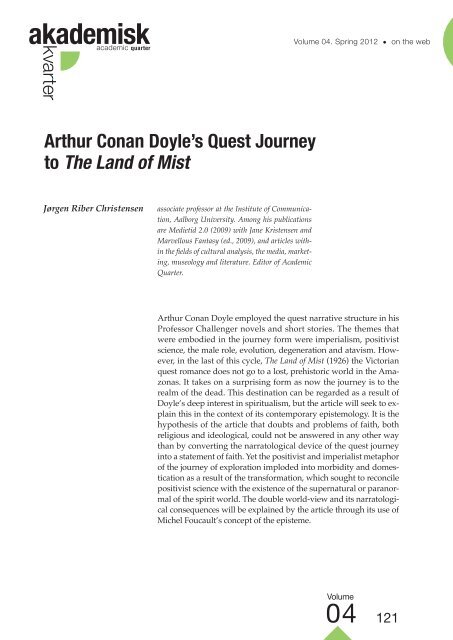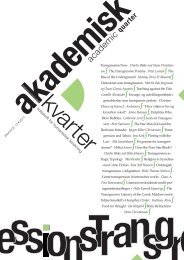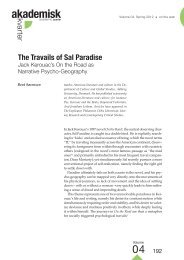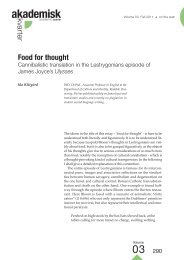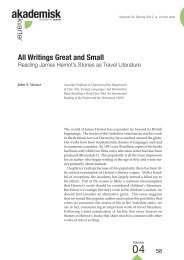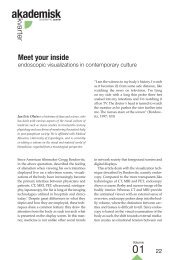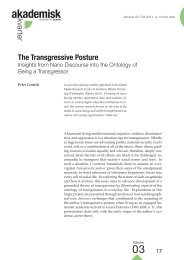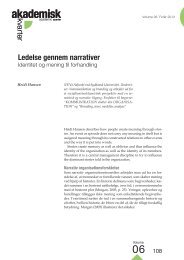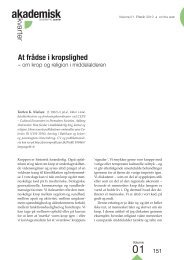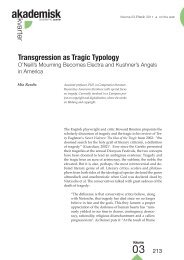Arthur Conan Doyle's Quest Journey to The Land of Mist
Arthur Conan Doyle's Quest Journey to The Land of Mist
Arthur Conan Doyle's Quest Journey to The Land of Mist
You also want an ePaper? Increase the reach of your titles
YUMPU automatically turns print PDFs into web optimized ePapers that Google loves.
akademiskacademic quarterkvarter<strong>Arthur</strong> <strong>Conan</strong> Doyle’s <strong>Quest</strong> <strong>Journey</strong> <strong>to</strong> <strong>The</strong> <strong>Land</strong> <strong>of</strong> <strong>Mist</strong>Jørgen Riber Christensensuch. Pr<strong>of</strong>essor Challenger is aggressively and sceptically opposingthe spiritualist movement, but after his dead wife has shown herself<strong>to</strong> him in spirit form, and Enid has shown her abilities as aspiritualist medium, he <strong>to</strong>o is convinced. In “<strong>The</strong> DisintegrationMachine” an inven<strong>to</strong>r, <strong>The</strong>odore Nemor demonstrates his infernalmachine <strong>to</strong> Pr<strong>of</strong>essor Challenger and Edward Malone telling themthat he will sell it <strong>to</strong> the Russians as a weapon <strong>to</strong> be used againstBritain. Challenger tricks the inven<strong>to</strong>r in<strong>to</strong> his own machine anddisintegrates him. Also “When the World Screamed” is concernedwith science. Pr<strong>of</strong>essor Challenger has formed the hypothesis thatthe Earth and other planets are living organisms, and he has hired askilled artesian-well engineer <strong>to</strong> sink a sharp drill in<strong>to</strong> the core <strong>of</strong>the Earth. Challenger is right, and the Earth reacts <strong>to</strong> the stabbingby screaming and by erupting an organic fluid and secretions fromthe hole. Volcanoes erupt all over the globe, and the pr<strong>of</strong>essor iscelebrated as a scientific genius.<strong>The</strong>matically the five Challenger texts deal with responses <strong>to</strong>aspects <strong>of</strong> modernity. <strong>The</strong> Lost World is about Darwinism and survival<strong>of</strong> the fittest, or more precisely about degeneration theoriesthat claim that evolution in nature and in society may move backward<strong>to</strong> earlier atavistic forms. Ironically, the “the greatest brainin Europe” (Doyle, 1995, p. 438), the pr<strong>of</strong>essor himself, is almostphysically identical <strong>to</strong> the chief <strong>of</strong> the ape-men on the inaccessibleplateau in the Amazonas. Challenger as the so-called higher degenerate(Lombroso, 1876: Greenslade, 1995) is described by thenarra<strong>to</strong>r, Malone as “a primitive cave-man in a lounge suit” (Doyle,1912/1995, p. 438), and it is his primeval aggressiveness that hasequipped him with “a driving force that can turn all his dreamsin<strong>to</strong> facts.” Doyle’s societal critique here, in which the lack <strong>of</strong> basicsocial skills paired with superhuman abilities becomes an instrumen<strong>to</strong>f survival, is again combined with another discourse, thegendered one about the male role. Edward Malone joins the evolutionary,scientific quest <strong>to</strong> the Amazonas in order <strong>to</strong> prove his manhood<strong>to</strong> his fiancée Gladys, who will not have him unless he candisplay some manly, heroic qualities. Again, Doyle’s societal critiqueis apparent. When Malone returns a better man <strong>to</strong> his Londonsuburb it is only <strong>to</strong> find that his Gladys has married a solici<strong>to</strong>r’sclerk, “a little ginger-haired man, who was coiled up in thedeep arm-chair” (Doyle, 1995, p. 167).Volume04 123
akademiskacademic quarterkvarter<strong>Arthur</strong> <strong>Conan</strong> Doyle’s <strong>Quest</strong> <strong>Journey</strong> <strong>to</strong> <strong>The</strong> <strong>Land</strong> <strong>of</strong> <strong>Mist</strong>Jørgen Riber Christensen<strong>The</strong> apocalyptic novel <strong>The</strong> Poison Belt continues the scientific andevolution discourses in combination with an imperialist one. <strong>The</strong>poisonous effect <strong>of</strong> the ether does not affect everybody in the sameway: “the less developed races have been the first <strong>to</strong> respond <strong>to</strong> itsinfluence. <strong>The</strong>re are deplorable accounts from Africa, and the Australianaborigines appear <strong>to</strong> have been already exterminated. <strong>The</strong>Northern races have as yet shown greater resisting power than theSouthern… <strong>The</strong> Slavonic population <strong>of</strong> Austria is down, while theTeu<strong>to</strong>nic has hardly been affected.” (Doyle, 1995, p. 194).<strong>The</strong>matically, the last <strong>of</strong> the Challenger novels, <strong>The</strong> <strong>Land</strong> <strong>of</strong> <strong>Mist</strong>is a combination <strong>of</strong> discourses; but now science is combined withreligion, and it is this combination within the narrative framework<strong>of</strong> a quest structure that is the subject <strong>of</strong> the rest <strong>of</strong> this article.<strong>The</strong> quest romance and the scientific quest<strong>Conan</strong> Doyle’s production <strong>of</strong> the Sherlock Holmes cases was highlyformulaic, almost mechanically repetitive in its narrative pattern,though the concept was highly original and successful in its time(Christensen, 2010). Also in the Challenger novels the same narrativestructure was employed by Doyle. <strong>The</strong> quest has its root inmyths and religions, and it has been a recurring and relatively unchangingphenomenon in cultural his<strong>to</strong>ry with manifestations ine.g. medieval romances, fantasy and popular films (Campbell,1949/1975; Vogler, 1995/1999). <strong>The</strong> quest is a journey. It is circular,and may be compared <strong>to</strong> the folktale structure <strong>of</strong> at home – out –home again, as the questing hero is sent on a mission <strong>to</strong> foreignparts <strong>to</strong> retrieve some kind <strong>of</strong> an elixir that can save his homeland.<strong>The</strong> quest runs through certain steps. <strong>The</strong> hero is called <strong>to</strong> adventure;sometimes he is abducted or lured away. He then has <strong>to</strong> crossthe threshold <strong>of</strong> adventure. <strong>The</strong> threshold is guarded, and theguard must be defeated or the hero may have <strong>to</strong> trick or negotiatehis way in<strong>to</strong> the otherworld. In some cases the hero is killed at thisstage, and the otherworld becomes the land <strong>of</strong> death. After thethreshold-crossing the hero is subjected <strong>to</strong> various tests in the form<strong>of</strong> e.g. brother battles, dragon battles or dismemberment. <strong>The</strong> continuedjourney can change in<strong>to</strong> abduction, the so-called night-seajourney or underground journey. At this point <strong>of</strong> the quest journeyits clearly symbolic nature becomes apparent, where the otherworldresembles unconscious structures <strong>of</strong> the mind. Other varia-Volume04 124
akademiskacademic quarterkvarter<strong>Arthur</strong> <strong>Conan</strong> Doyle’s <strong>Quest</strong> <strong>Journey</strong> <strong>to</strong> <strong>The</strong> <strong>Land</strong> <strong>of</strong> <strong>Mist</strong>Jørgen Riber Christensentions are the wonder journey, or the hero may be swallowed andenter the whale’s or monster’s belly. Both before and during thequest journey the hero encounters and is allied with an assortmen<strong>to</strong>f helpers, who may each possess a special ability. At the end <strong>of</strong> thejourney, farthest away from home, the hero meets with the goal <strong>of</strong>his quest. He now has <strong>to</strong> pass the ultimate test and get the rewardfor the journey and his pains. <strong>The</strong> reward may be the hero’s sexualgratification with a goddess <strong>of</strong> the otherworld, and / or reconciliationwith a father-figure. <strong>The</strong> reward may even be apotheosis, andthe hero becomes a god-like figure. More negatively, he may have<strong>to</strong> steal the prize he came <strong>to</strong> win and the homeward journey becomesflight. <strong>The</strong> reward the hero brings home is an elixir in some,symbolic or literal form, which can cure the ailing kingdom fromwhich he set <strong>of</strong>f. In itself the homeward journey is filled with obstacles,but the hero returns home a changed and wiser personwith the elixir, which also improves or heals his native country.<strong>The</strong> Vic<strong>to</strong>rian quest romance is a particular instance <strong>of</strong> the generalquest narrative pattern as it has been described briefly above.Apart from <strong>Conan</strong> Doyle its literary practitioners were R.L. Stevenson(e.g. Treasure Island, 1881), H. Rider Haggard (e.g. KingSolomon’s Mines, 1885), Rudyard Kipling (e.g. <strong>The</strong> Man Who WouldBe King, 1888) and H.G. Wells (e.g. <strong>The</strong> Time Machine, 1895). Onetheme that tied these authors’ quest novels <strong>to</strong>gether was the discussion<strong>of</strong> the changing male gender role. <strong>The</strong> very genre was par<strong>to</strong>f this discussion as the relatively short and action-packed questromances defined themselves in opposition <strong>to</strong> the prevalent threevolumerealistic novel with its largely female readership (Fraser,1998, p. 3). <strong>The</strong>se male Vic<strong>to</strong>rian quest romances were highly <strong>to</strong>picalin their thematics in other respects, <strong>to</strong>o. Positivist science is atthe surface <strong>of</strong> H.G. Wells’ production, which is <strong>of</strong>ten labelled asthe subgenre, the scientific quest. <strong>The</strong> scientific quest connects theVic<strong>to</strong>rian quest genre per se with science fiction. With forerunnerssuch as Jules Verne the terri<strong>to</strong>rial quest could examine the futurein the genre <strong>of</strong> science fiction. However, it is in its very journeyform the quest narrative in itself embodies the search for empiricalknowledge when the quest is for the confirmation or verification<strong>of</strong> factual truths. <strong>The</strong> Empire as a theme is also formally connected<strong>to</strong> the quest narrative as this genre reflects the imperialexpansion and its consequences. Not only the fate <strong>of</strong> the BritishVolume04 125
akademiskacademic quarterkvarter<strong>Arthur</strong> <strong>Conan</strong> Doyle’s <strong>Quest</strong> <strong>Journey</strong> <strong>to</strong> <strong>The</strong> <strong>Land</strong> <strong>of</strong> <strong>Mist</strong>Jørgen Riber Christensenmale colonial administra<strong>to</strong>r and his journey overseas, but also theclash <strong>of</strong> cultures, which was sometimes regarded in a Darwinistlight, were stable ingredients <strong>of</strong> the novels.<strong>The</strong> reformulation <strong>of</strong> the quest romancein <strong>The</strong> <strong>Land</strong> <strong>of</strong> <strong>Mist</strong><strong>Conan</strong> Doyle’s <strong>The</strong> Lost World almost follows the narrative queststructure <strong>to</strong> the letter. Basically, a group <strong>of</strong> men departed for unknowndestinations in search <strong>of</strong> knowledge, wealth, honour andpersonal development. <strong>The</strong> classic quest elements are represented:<strong>The</strong> call <strong>to</strong> adventure, an assortment <strong>of</strong> helpers, an abduction <strong>of</strong>Challenger by ape-men, wonder journeys up <strong>to</strong> the plateau, and anunderground journey down again, dragon battles with dinosaurs,sexually attractive native women, the brother battle between Challengerand his alter ego, the ape-man chief. <strong>The</strong> questers did no<strong>to</strong>nly gain insights in<strong>to</strong> their own characters and male roles, but theycould also return <strong>to</strong> London with a scientific discovery in the form<strong>of</strong> a living pterodactyl and £200,000 worth <strong>of</strong> diamonds.<strong>The</strong> Poison Belt is a step <strong>to</strong>wards the rather special way Doyleused the Vic<strong>to</strong>rian quest romance in <strong>The</strong> <strong>Land</strong> <strong>of</strong> <strong>Mist</strong>. In the former<strong>of</strong> the two the call <strong>to</strong> adventure from Challenger <strong>to</strong> Malone, Rox<strong>to</strong>nand Summerlee is merely <strong>to</strong> join him in his comfortable home outsideLondon on a hill<strong>to</strong>p in pas<strong>to</strong>ral surroundings with a view <strong>to</strong> agolf course and a railway line, and the bulk <strong>of</strong> the action takes placein a sealed sitting-room in the pr<strong>of</strong>essor’s home only supplementedwith a flow <strong>of</strong> telegrams from all over the world as the apocalypsestrikes. <strong>The</strong>re are quite dramatic occurrences outside the large windowas the poisonous ether also reaches this part <strong>of</strong> England. <strong>The</strong>questers do not have <strong>to</strong> journey in this novel as they cross thethreshold <strong>of</strong> adventure in the way that it comes <strong>to</strong> them in the form<strong>of</strong> a poison belt <strong>of</strong> ether with a speed <strong>of</strong> “some million miles a minute”,which kills all humans on its way. <strong>The</strong> quest structure is actuallyfollowed as here the otherworld is the land <strong>of</strong> death and thereturn is resurrection near the end <strong>of</strong> the novels when the questershave run out <strong>of</strong> oxygen, but at a time when the ether has passed.Two points are notable in the use <strong>of</strong> the quest narrative leadingon <strong>to</strong> its further use in <strong>The</strong> <strong>Land</strong> <strong>of</strong> <strong>Mist</strong>. <strong>The</strong>re is the morbidity withthe apocalypse and the seeming extinction <strong>of</strong> mankind as it is depictedin the chapter called “<strong>The</strong> Dead World” with a journeyVolume04 126
akademiskacademic quarterkvarter<strong>Arthur</strong> <strong>Conan</strong> Doyle’s <strong>Quest</strong> <strong>Journey</strong> <strong>to</strong> <strong>The</strong> <strong>Land</strong> <strong>of</strong> <strong>Mist</strong>Jørgen Riber Christensenthrough a post-apocalyptic London, and there is the domestication<strong>of</strong> the quest genre where the action has moved in<strong>to</strong> a closed, claustrophobicroom in an English home.<strong>The</strong> late date <strong>of</strong> 1926 in the genre his<strong>to</strong>ry <strong>of</strong> <strong>The</strong> <strong>Land</strong> <strong>of</strong> <strong>Mist</strong> andin the his<strong>to</strong>ry <strong>of</strong> the British Empire becomes apparent when LordRox<strong>to</strong>n has <strong>to</strong> insert an advertisement in a newspaper <strong>to</strong> find newquests. <strong>The</strong> call <strong>to</strong> adventure in the quest structure now seems <strong>to</strong> beso low that it can hardly be heard. He has exhausted the “sportingadventures <strong>of</strong> this terrestrial globe”, and is “seeking fresh worlds <strong>to</strong>conquer” (Doyle, 1995, p. 319); but these so-called fresh worlds areeven more gloomy than those in <strong>The</strong> Poison Belt as Rox<strong>to</strong>n specifiesthem as a haunted house, thus in this reformulation <strong>of</strong> the Vic<strong>to</strong>rianquest romance domestication is combined with morbidity. <strong>The</strong> domestication<strong>of</strong> the quest is stressed when its goal, the so-called scientificpro<strong>of</strong> <strong>of</strong> an afterlife is discovered right in the intimate sphere,as it is the relationship between a husband and wife that providesthe sought for evidence, and in this way the structure home – out– home again has imploded: <strong>The</strong> otherworld is at home, and thegeographical quest has become psychic research, or a “psychicquest” as it is called in the novel (Doyle 1995, p. 341). <strong>The</strong> aim <strong>of</strong> thisquest is verification <strong>of</strong> an afterlife, and the helpers and guides <strong>of</strong> thetraditional quest narrative have now become spiritualist mediums,who open the way in<strong>to</strong> the realm <strong>of</strong> the dead for further investigation,and the séance in private-living-rooms the threshold <strong>of</strong> adventure.Has the quest formula then become a scientific quest? Andanswer could be that the word “science” <strong>to</strong>gether with “scientific”has 52 instances in the novel, but there are numerous other indicationsthat Doyle’s motivation for writing this new Challenger novelis a wish <strong>to</strong> reconcile positivist science with the existence <strong>of</strong> the supernaturalor paranormal <strong>of</strong> the spirit world.<strong>The</strong> narrative form is in itself a sign that it has been necessary <strong>to</strong>reformulate the quest genre. <strong>The</strong> narra<strong>to</strong>r <strong>of</strong> the other Challengernovels has primarily been an omniscient, impersonal one and sometimesthe journalist Edward Malone, but the narra<strong>to</strong>r <strong>of</strong> <strong>The</strong> <strong>Land</strong> <strong>of</strong><strong>Mist</strong> becomes more and more an intrusive one, and this <strong>to</strong> the extentthat not only the quest formula, but also its fictional status aredismantled. In his attempt <strong>to</strong> verify spiritualism the voice <strong>of</strong> thenarra<strong>to</strong>r is taken over by Doyle himself. He asks the reader rhe<strong>to</strong>ricalquestions, and notes and lengthy appendices are added <strong>to</strong>Volume04 127
akademiskacademic quarterkvarter<strong>Arthur</strong> <strong>Conan</strong> Doyle’s <strong>Quest</strong> <strong>Journey</strong> <strong>to</strong> <strong>The</strong> <strong>Land</strong> <strong>of</strong> <strong>Mist</strong>Jørgen Riber Christensenthe novel. <strong>The</strong>se appendices may contain passages such as: “<strong>The</strong>scenes in this chapter are drawn either very closely from personalexperience or from the reports <strong>of</strong> careful and trustworthy experimenters.”(Doyle, 1995, p. 416) or “<strong>The</strong> account <strong>of</strong> Pithecanthropusis taken from the Bulletin de l’Institut Métaphychique (Doyle, 1995, p.419). <strong>The</strong> text <strong>of</strong> the novel itself is interrupted by directions <strong>to</strong> theappendices: “For the incidents recorded in this chapter vide Appendix.”(Doyle, 1995, p. 352). <strong>The</strong> comments <strong>of</strong> the intrusive narra<strong>to</strong>rare part <strong>of</strong> the rhe<strong>to</strong>rical pattern <strong>of</strong> the novel. Prolonged debatingsections are inserted in<strong>to</strong> the action <strong>of</strong> the novel, in whichscepticism <strong>of</strong> spiritualism and the spiritualist movement are givenwords, only <strong>to</strong> be refuted again and again. Positivist science andspiritualism are fused when the term “spiritualist science” is usedand experiments are described in a labora<strong>to</strong>ry setting (Doyle, 1995,pp. 361-370). One <strong>of</strong> the results <strong>of</strong> these experiments is not only theverification <strong>of</strong> an afterlife, but also <strong>of</strong> the theory <strong>of</strong> evolution withechoes from <strong>The</strong> Lost World. <strong>The</strong> missing link “either an ape-likeman or a man-like ape” is summoned during the séance. In <strong>The</strong>His<strong>to</strong>ry <strong>of</strong> Spiritualism Doyle’s carries the idea <strong>of</strong> physical evolutionin<strong>to</strong> the afterlife, when he writes that “evolution has been veryslow upon the physical plane, at it is slow also on the spiritualone…we shall evolve from heaven <strong>to</strong> heaven until the destiny <strong>of</strong>the human soul is lost in a blaze <strong>of</strong> glory whither the eye <strong>of</strong> imaginationmay not follow.” (Doyle, 1926, Vol. II, p. 110).<strong>The</strong> <strong>Land</strong> <strong>of</strong> <strong>Mist</strong> is situated in the context <strong>of</strong> Doyle’s many spiritualistworks, which are not fictional. His main spiritualist oeuvre is<strong>The</strong> His<strong>to</strong>ry <strong>of</strong> Spiritualism (Doyle, 1926), and some <strong>of</strong> his other spiritualistpublications are: <strong>The</strong> New Revelation (1918), Life After Death(1918), <strong>The</strong> Vital Message (1919), Our Reply <strong>to</strong> the Cleric (1920), Spiritualismand Rationalism (1920), <strong>The</strong> Wanderings <strong>of</strong> a Spiritualist (1921),Spiritualism—Some Straight <strong>Quest</strong>ions and Direct Answers (1922), <strong>The</strong>Case for Spirit Pho<strong>to</strong>graphy (1922), Our American Adventure (1923),Our Second American Adventure (1924). <strong>The</strong> Early Christian Churchand Modern Spiritualism (1925), Psychic Experiences (1925), PheneasSpeaks (1927), Spiritualism (c.1927), What does Spiritualism ActuallyTeach and Stand For? (1928), and in Doyle’s au<strong>to</strong>biography he writesin its last chapter that the psychic question has come <strong>to</strong> absorb thewhole energy <strong>of</strong> his life, and that he and his wife “have now travelleda good thousand miles upon our quest. We have spoken faceVolume04 128
akademiskacademic quarterkvarter<strong>Arthur</strong> <strong>Conan</strong> Doyle’s <strong>Quest</strong> <strong>Journey</strong> <strong>to</strong> <strong>The</strong> <strong>Land</strong> <strong>of</strong> <strong>Mist</strong>Jørgen Riber Christensen<strong>to</strong> face with a quarter <strong>of</strong> a million people.” (Doyle, 1924/2007, pp.342-343). In his letters Doyle writes about his many and successfulpublic lecturing <strong>to</strong>urs about spiritualism, but also about his personalexperiences at séances <strong>of</strong> contacts with deceased family members,especially with his dead son Kingsley (Doyle, 2008, p. 654).A rupture <strong>of</strong> epistemes?<strong>The</strong> ultimate aim for <strong>Conan</strong> Doyle and the movement <strong>of</strong> spiritualismwas <strong>to</strong> produce the empirical evidence <strong>of</strong> contacts with spirits.If scientific pro<strong>of</strong> <strong>of</strong> this kind could be irrefutably presented <strong>to</strong> theworld the cause <strong>of</strong> the spiritualist movement would obviouslybenefit from it, and the existence <strong>of</strong> an afterlife could be demonstrated;but also positivist science and religious belief could bereconciled and united within the same world picture. Instead <strong>of</strong>science overthrowing faith, spiritualism could in other words beregarded as an experimental science about a natural continuation<strong>of</strong> life after death, and not only as a religious belief, and the supernaturalcould become natural. This attitude is expressed in <strong>The</strong>London Spiritual Magazine:Spiritualism is a science based solely upon facts; it is neither speculativenor fanciful. On facts and facts alone, open <strong>to</strong> the whole worldthrough an extensive and probably unlimited system <strong>of</strong> mediumship,it builds upon a substantial psychology on the ground <strong>of</strong> strictestlogical induction. Its cardinal truth, imperishably established onthe experiments and experiences <strong>of</strong> millions <strong>of</strong> sane men and women,<strong>of</strong> all countries and creeds, is that <strong>of</strong> a world <strong>of</strong> spirits, and thecontinuity <strong>of</strong> the existence <strong>of</strong> the individual spirit through the momentaryeclipse <strong>of</strong> death; as it disappears on earth reappearing inthat spiritual world, and becoming an inhabitant amid the ever-augmentingpopulation <strong>of</strong> the spiritual universe. (Wallace, 1892, p. 645)How does one seek <strong>to</strong> explain this very <strong>of</strong>ten sincere, but alsoapparently desperate and incredibly credulous attempt <strong>to</strong> believeboth in spirits, which could materialize ec<strong>to</strong>plasm and in positivistscience, which rests on hypotheses that can be tested by empiricalknowledge? This question can be rephrased in<strong>to</strong> one <strong>of</strong> theepistemology <strong>of</strong> the period, where it seems that two systems conflicted,but also co-existed, in spiritualism. Michel Foucault’s concep<strong>to</strong>f epistemes is a possible way <strong>to</strong> understand this complexepistemology.Volume04 129
akademiskacademic quarterkvarter<strong>Arthur</strong> <strong>Conan</strong> Doyle’s <strong>Quest</strong> <strong>Journey</strong> <strong>to</strong> <strong>The</strong> <strong>Land</strong> <strong>of</strong> <strong>Mist</strong>Jørgen Riber ChristensenIn his <strong>The</strong> Archaeology <strong>of</strong> Knowledge (Foucault, 1969/2011) Foucaultdescribes how the epistemology <strong>of</strong> a certain his<strong>to</strong>rical period isbased on unconscious assumptions, beliefs and values with accompanyingformational rules, systematic shaping fac<strong>to</strong>rs and conceptual,possibilities about specific fields <strong>of</strong> knowledge, e.g. the humanbody, the mind, the natural world or economy. Foucault calls thesesystems epistemes. Negatively, an episteme sets up boundaries forthoughts about a scientific subject in a period. This archaeology <strong>of</strong>knowledge includes discontinuity and rupture, as an episteme maychange rapidly, or one episteme may replace another. This changefundamentally affects what is considered valid knowledge in itself,and the very content <strong>of</strong> scientific discourses changes.Though one episteme may supplant another, this does not necessarilymean that the take-over is complete and all-embracing. <strong>The</strong>remay be contemporaneity <strong>of</strong> two epistemes, and Foucault writes that“one can, on the basis <strong>of</strong> these new rules, describe and analyse phenomena<strong>of</strong> continuity, return and repetition” (Foucault, 1969/011, p.191), and one may not imagine “that rupture is a sort <strong>of</strong> great driftthat carries with it all discursive formations at once (Foucault,1969/011, p. 193). It is the point <strong>of</strong> this article that spiritualism as anepistemological effort is an instance <strong>of</strong> double epistemes in the sensethat spiritualism as it is also depicted in <strong>The</strong> <strong>Land</strong> <strong>of</strong> <strong>Mist</strong> both manifesteda full acceptance <strong>of</strong> the positivist scientific, new, modernworld and also retained the episteme <strong>of</strong> a pre-secularized worldwithout being ready yet <strong>to</strong> let go <strong>of</strong> it. It is in this way that the apparentcontradictions in the movement and in one <strong>of</strong> its fictional manifestations<strong>The</strong> <strong>Land</strong> <strong>of</strong> <strong>Mist</strong> can be unders<strong>to</strong>od and explained.Conclusion: <strong>The</strong> best <strong>of</strong> two worldsSpiritualism as it is described in Doyle’s novel was on a quest <strong>to</strong> usethe scientific world-view <strong>of</strong> a new episteme <strong>to</strong> maintain the religiousor supernatural <strong>of</strong> the episteme that had already been ousted andsupplanted, and thus attempting <strong>to</strong> merge the best <strong>of</strong> two worlds.This article has described how the terri<strong>to</strong>rial journey <strong>of</strong> the questnarrative as used narra<strong>to</strong>logically in <strong>The</strong> Lost World with its evolutionaryscientific, epistemological discourse was transformed inboth <strong>The</strong> Poison Belt and in <strong>The</strong> <strong>Land</strong> <strong>of</strong> <strong>Mist</strong>. In these two Challengernovels <strong>Conan</strong> Doyle domesticated the geographical quest,and in the latter novel he also disrupted the novel genre with anVolume04 130
akademiskacademic quarterkvarter<strong>Arthur</strong> <strong>Conan</strong> Doyle’s <strong>Quest</strong> <strong>Journey</strong> <strong>to</strong> <strong>The</strong> <strong>Land</strong> <strong>of</strong> <strong>Mist</strong>Jørgen Riber Christensenintrusive narra<strong>to</strong>rial voice and appendices that again and againstressed a scientific approach <strong>to</strong> the subject <strong>of</strong> spiritualism. <strong>The</strong>contradiction inherent in this simultaneous fictionalisation <strong>of</strong> twoFoucauldian epistemes had its costs. One, as pointed out, was thebreak-down <strong>of</strong> the Vic<strong>to</strong>rian quest romance; another was the generalapocalyptical and morbid atmosphere and sense <strong>of</strong> loss andpessimism <strong>of</strong> the two last Challenger novels that contrasts stronglywith the sense <strong>of</strong> epistemological vic<strong>to</strong>ry and triumph in the firstChallenger novel, <strong>The</strong> Lost World.ReferencesCampbell, J., 1949/1975. <strong>The</strong> Hero with a Thousand Faces. SphereBooks: London.Fraser, R., 1998. Vic<strong>to</strong>rian <strong>Quest</strong> Romance. Northcote House: Plymouth.Christensen, J. Riber, 2010. <strong>Conan</strong> Doyle’s «<strong>The</strong> Adventure <strong>of</strong> theSix Napoleons» and the Mechanical Reproduction <strong>of</strong> the SherlockHolmes Formula in Christensen, J. Riber and K. T<strong>of</strong>t Hansen(eds.), 2010. Fingeraftryk Studier i krimi og det kriminelle: Festskrifttil Gunhild Agger. Aalborg Universitetsforlag: Aalborg, pp.387-405.Coley, N. G. and Hall, V.M.D. (eds.), 1980. Darwin <strong>to</strong> Einstein PrimarySources on Science and Belief, <strong>The</strong> Open University Press: Burnt Mill.Doyle, A. <strong>Conan</strong>, 1926. A His<strong>to</strong>ry <strong>of</strong> Spiritualism Vols. I-II, Amazon: Kindleedition.Doyle, A. <strong>Conan</strong>, 1924/2007. Memories and Adventures An Au<strong>to</strong>biography,Wordsworth Literary Lives: Ware Hertfordshire.Doyle, A. <strong>Conan</strong>, Lellenberg, J., Stashower, D. and Foley, C. (eds.), 2008.A Life in Letters, Harper: London.Doyle, A. <strong>Conan</strong>, 1995. <strong>The</strong> Lost World and Other S<strong>to</strong>ries, WordsworthClassics: Ware Hertfordshire.Foucault, M., 1969/2011. <strong>The</strong> Archeology <strong>of</strong> Knowledge, Routledge:London.Green, R.L. and J. M Gibson, 2000. A Bibliography <strong>of</strong> A. <strong>Conan</strong> Doyle,Hudson House: Bos<strong>to</strong>n.Greenslade, W., 1994. Degeneration, Culture and the Novel, CambridgeUniversity Press: Cambridge.Jay, M. and M. Neve (eds.), 1999. 1900: A Fin-de-siécle Reader, Penguin:Harmondsworth.Volume04 131
akademiskacademic quarterkvarter<strong>Arthur</strong> <strong>Conan</strong> Doyle’s <strong>Quest</strong> <strong>Journey</strong> <strong>to</strong> <strong>The</strong> <strong>Land</strong> <strong>of</strong> <strong>Mist</strong>Jørgen Riber ChristensenLombroso, C. and G. Lombroso-Ferrero, 1876/1972. Criminal Man,According <strong>to</strong> the Classification <strong>of</strong> Cesare Lombroso, N.J.: Montclair.Orel, H. (ed.), 1992. Critical Essays on Sir <strong>Arthur</strong> <strong>Conan</strong> Doyle, G.K.Hall & Co.: New York.Vogler, C., 1992/1999. <strong>The</strong> Writer’s <strong>Journey</strong> Mythic Structure for S<strong>to</strong>rytellersand Screenwriters. London.Wallace, A.R., 1892. Spiritualism, Chambers Encyclopaedia, pp. 645-648in Coley and Hall, pp. 50-58.Volume04 132


